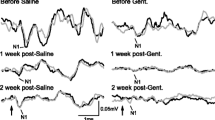Summary
Vancomycin has been successfully used clinically for many years. Although early reports found ototoxicity to be a side effect of this antibiotic, later studies could not confirm this. For this reason we have started an experimental study in an animal model on the ototoxic effects of vancomycin. We now report the results of this study. Fourteen healthy Mongolian gerbils were treated with intraperitoneal injections of vancomycin (80 mg/kg per day) for a 2-week period. Before and after treatment each animal's hearing was evaluated by evoked response audiometry. Post mortem the cochleae were investigated by scanning electron microscopy in Amsterdam and by microdissection with surface preparations (hair cell counting) in Stockholm. The results of this study show that there is no clear evidence for the existence of ototoxicity due to vancomycin in this dosage.
Similar content being viewed by others
References
Brummett RE (1981) Effects of antibiotic-diuretic interactions in the guinea pig model of ototoxicity. Rev Infect Dis [Suppl] 3:216–223
Cook FV, Farrar WE (1978) Vancomycin revisited. Ann Intern Med 88:813–818
Davis RR, Brummett RE, Bendrick TW, Himes DI (1982) The ototoxic interaction of viomycin, capreomycin and polymyxin B with ethacrynic acid. Acta Otolaryngol (Stockh) 93:211–217
Dutton AAC, Elmes PC (1959) Vancomycin: report on treatment of patients with severe staphylococcal infection. Br Med J 1:1144–1149
Geraci JE, Heilman FR, Nichols DR, Wellman WE (1958) Antibiotic therapy of bacterial endocarditis. VII. Vancomycin for acute micrococcal endocarditis. Proc Mayo Clin 33:172–181
Kavanagh KT, McCabe BF (1983) Ototoxicity of oral neomycin and vancomycin. Laryngoscope 93:649–653
Mellor JA, Kingdom J, Cafferkey M, Keane CT (1984) Vancomycin ototoxicity in patients with normal renal function. Br J Audiol 18:179–180
Mellor JA, Kingdom J, Cafferkey M, Keane CT (1985) Vancomycin toxicity: a prospective study. J Antimicrob Chemother 15:773–780
Schaad UB, Nelson JD, McCracken GH (1981) Pharmacology and efficacy of vancomycin for staphylococcal infection in children. Rev Infect Dis [Suppl] 3:282–288
Sorrel TC, Collignon PJ (1985) A prospective study of the adverse reactions associated with vancomycin therapy. J Antimicrob Chemother 16:235–241
Tange RA, Conijn EAJG, Zeijl LPGM van, Huizing EH (1982) Pattern of gentamicin-induced cochlear degeneration in the guinea pig: a morphological and electrophysiological study. Arch Otorhinolaryngol 236:173–184
Traber PG, Levine DP (1981) Vancomycin ototoxicity in a patient with normal renal function. Ann Intern Med 95:458–460
Wenzel RP (1982) The emergence of methicillin resistant Staphylococcus aureus. Ann Intern Med 97:440–442
Author information
Authors and Affiliations
Rights and permissions
About this article
Cite this article
Tange, R.A., Kieviet, H.L., Marle, J.v. et al. An experimental study of vancomycin-induced cochlear damage. Arch Otorhinolaryngol 246, 67–70 (1989). https://doi.org/10.1007/BF00457456
Received:
Accepted:
Issue Date:
DOI: https://doi.org/10.1007/BF00457456




